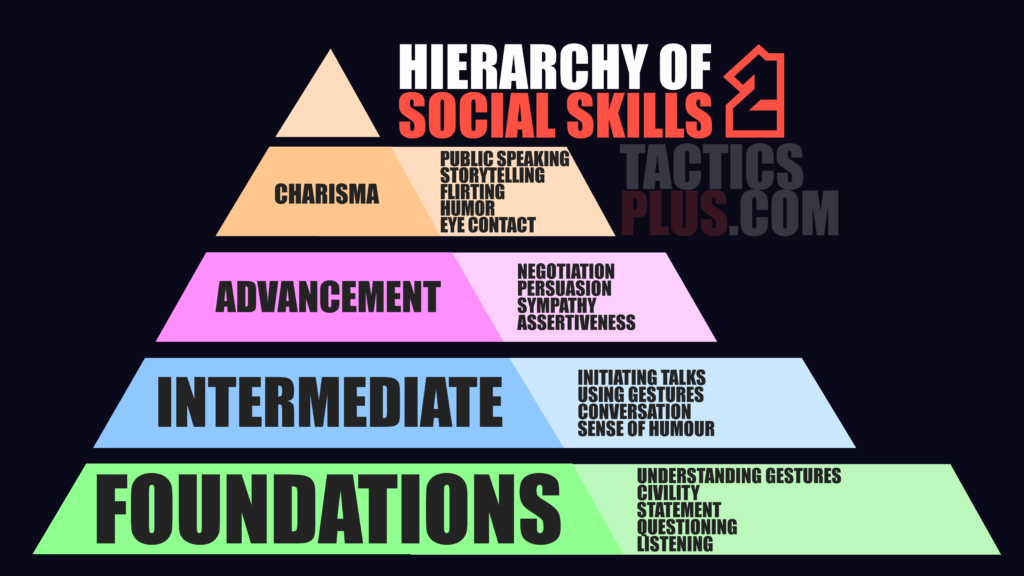Introduction.
Explore the hierarchy of social skills where I rank order the social skills based on how fundamental they are, leading to the ones associated with charisma. I’ll also include social skill activities & free (and paid) resources at each level to help you improve your social skills.

The Foundation.
1. Listening.
Active listening is the most basic social skill, since you can be a functioning individual in society with just this skill.
Imagine a very socially awkward person who has no idea how to interact with anyone, but even they can listen to people and act on it. All you have to do is pay attention.
I’ve been in many social situations where all I did was just listen (and ask), and the other person thought it was the best conversation of his life.
2. Questioning.
Asking questions about the content of the conversation is also one of the most basic social skills. People with poor social skills can often rely solely on these two skills, which will make the conversation seem quite boring, but at least people won’t think you have zero social skills.
The purpose of questioning is to keep the other person talking or to obtain the information you need. The latter is the more basic version.
You can ask closed-ended questions that elicit only a “yes” or “no” answer, or open-ended questions that require the person to provide a detailed response.
Pro tip: Experts often suggest asking open-ended questions to keep the conversation flowing, but I think this advice tends to confuse people, leading them to overthink the type of questions to ask.
Continuing to ask questions on a particular topic can eventually turn a closed-ended question into an open-ended one.
Here’s an example, with CE representing close-ended and OE representing open-ended:
- Q: What university do you go to? (CE)
- A: Oxford.
- Q: How’s it? (CE)
- A: Good.
- Q: How has your experience been? (OE)
Another thing to remember is that open-ended questions often start with words like “why” or “how.”
One activity you can do to practice this social skill is to ask open-ended questions during chat conversations using voice notes.
This gives you enough time to think about each question, and verbalizing them helps you get used to realistic social interactions.
3. Statement.
A statement ends with a full stop. It’s the information you’re giving the listener, like saying, “I’ll be there at 5.”
While you can get away with minimal or no statements in a social setting, basic statements will still be expected even from people with the poorest social skills.
Even a simple “yes” or a nod counts as a statement.
Activity:
- An activity to train this social skill is to reduce your filter. Most of what you think shouldn’t be said is socially acceptable. So, the next time something comes up in your mind that you believe you shouldn’t say for any reason, say it, slowly and loudly.
Here are some examples of statements ranging from the most basic to those of a good communicator:
- Yes, that’s fine.
- I live near the garden.
- I also like fantasy novels.
- Yes, the latest episode of House of the Dragon was great.
- I’m going to do a bachelor’s degree in UI/UX design because I’m interested in its union of aesthetics and function.
- I think cricket rankings for the best batsmen often don’t consider the level of competition faced by them at a given time. If you face mediocre bowlers, you tend to have more runs, average, and strike rate. So, these statistics can be misleading.
4. Civility.
Civility is formal politeness in behavior and speech. It involves talking and acting with respect toward others, a kind of politeness required even between close friends.
Knowing how much to say, how to offer constructive criticism, what to point out, and what to joke about are social rules that often remain unspoken.
Not being civil can mean being rude, like saying:
“Go and quickly bring me a glass of water” to a waiter at a restaurant.
A civil person might say something like:
“Can I please get a glass of water” and add a “Thank you.”
Socially anxious people typically have a broader categorization of what’s considered civil, while those who are socially rude think it’s too small. That’s why shy individuals tend to demonstrate more civility in their interactions.
To train civility in speech and behavior, I recommend my 30-day free course on assertiveness, in which “respect” plays a significant role.
5. Understanding Body Language.
Body language involves understanding non-verbal signals like facial expressions and gestures. When we talk with people, a lot of information is conveyed through their body language.
For instance, we can tell if we’ve said too much or if the other person is willing to do what we ask by observing their reactions.
If we ask a very personal question, and they make a strange face, it’s essential to recognize that cue and either change the subject or avoid pushing further.
Understanding gestures like a thumbs-up or a hand signal to lower one’s volume is also part of this social skill.
Paying attention to body language helps us navigate social interactions better, show respect for others’ boundaries, and build stronger connections with people.
Intermediate.
6. Sense of Humor.
Understanding humor involves having a sense of when someone is joking, appreciating it, and not taking everything literally or seriously.
If you’re engaged in a conversation about something controversial, and you happen to speak a little too loudly.
In response, your friend, with a touch of sarcasm, says, “Why don’t you just yell?” Surprisingly, you take it literally and start actually yelling. That’d be rare. That’s why sense of humor is also a fundamental social skill.
7. Conversation.
Conversation is too broad, so let’s make it simpler. A conversation is made of questions and statements.
The duration can range from a quick five-minute chat to an extended three-hour discussion, depending on the level of engagement between the participants.
When two people wish to talk, various skills come into play.
They need to find common topics, smoothly switch between subjects, connect different ideas, show genuine curiosity through questioning, and share information about themselves.
Understanding body language is crucial as well, as it helps recognize when someone wants to leave a conversation or is not interested, based on their non-verbal cues.
Training this social skill requires time and effort. Charisma University is a 30-day paid course that I found to be an effective way to enhance one’s conversation skills.
It’s full of social skill activities to help you get better at conversations.
Here are some free resources you may find valuable:
- 15 Tactics to Be More Articulate and Explain Anything to Anyone
- 10 Unique Communication Tips by Charisma Expert Vinh Giang
- 9 Tips and Ideas on How To Improve Conversation Skills
- Vinh Giang’s Free 3-Part Series on Communication
8. Using Gestures.
Just imagine not knowing how to wave your hand to say “hello” to someone!
Using gestures involves communicating non-verbally, where you convey messages without using your voice.
For example, you might shake your head to indicate “no” or use hand movements to show the size of something small, like a bottle, instead of providing its dimensions.
You can take your social skills up a level by using wide gestures while talking, as it enables you to communicate more effectively and engage people.
Incorporating gestures in conversations also helps others understand you better and allows for smoother interactions.
Resources:
- To make the most of this social skill, I recommend checking out my article on 20 Hand Gestures for Beginners to Copy. It will also help you get accustomed to using gestures comfortably in your interactions.
9. Initiating Social Interactions.
The beginner version of this skill involves initiating interactions that are essential for getting things done.
Simple tasks such as asking for directions or inquiring about the day fall under this category. As you progress, the advanced version includes initiating interactions with someone you’re attracted to, for instance.
An effective activity to train this social skill is to engage with people for no specific reason.
You can try asking for directions when you don’t need them or inquiring about the time even if you already know it.
I recall doing this with my friend; once we grew more comfortable, we took it to the next level by challenging each other with embarrassing tasks, like asking random people silly questions. I was once dared to ask a newspaper/bookseller to assess whether my back was straight or rounded while standing.
By practicing such activities, you become more at ease with initiating interactions and develop confidence in your social skills.
Free resource:
Advancement.
10. Assertiveness.
Assertiveness is the art of expressing your needs, opinions, and boundaries respectfully and confidently, aiming to avoid being passive or aggressive in communication.
My five-part assertiveness framework includes:
- Honesty.
- Boldness.
- Respect.
- Deliberation.
- Decisiveness.
I offer a comprehensive 30-day course for assertiveness training, where I guide individuals step-by-step to become more assertive by providing them with daily activities.
11. Empathy & Sympathy.
Empathy refers to the ability to understand how others are feeling, while sympathy involves offering support and showing compassion towards others.
Being empathetic means refraining from making jokes when your friend is feeling low or sad. Instead, you can try to understand their emotions and respond accordingly.
Activity:
- An activity to become more empathetic is to try to imagine why someone might have done something that you disliked. Put yourself in their shoes and see events from their perspective.
For instance, if you get angry at your mother for something she does, take some time to reflect on why she said or did it. - To enhance your ability to sympathize, memorize a few supportive phrases. These can be simple expressions like “I’m sorry” or “I can imagine how hard that must be”.
Pro tip: Sympathy & empathy can be powerful tools during arguments or debates. It makes others more receptive to your thoughts and open to changing their minds.
Example:
“I understand that’s your experience, and I have my own experiences, but every individual’s experiences are unique and may sometimes contradict each other.That’s why we can’t draw broad conclusions about a group of people based solely on our experiences.”
12. Persuasion.
Persuasion is the art of convincing or influencing others to adopt certain perspectives or make particular decisions.
We often use persuasion to encourage others to do something, like buying us a packet of chips or sharing their half of the tasty orange juice.
It’s important to recognize that persuasion is the backbone of negotiation. To be successful in a negotiation, you need to be able to persuade the other party to see things your way.
13. Negotiation.
Negotiating involves seeking agreements that meet the needs of all parties involved, resulting in a win-win solution to a problem. The goal is to find mutually beneficial resolutions to achieve common objectives.
For example, if you want a raise, you negotiate with your boss, starting with a request for a 5% raise, and through back-and-forth discussions, you both agree on a 3% salary increase.
In day-to-day situations, negotiation can be as simple as finding a compromise between different preferences.
For instance, if your friend wants to play football while you prefer swimming, you might agree to play football for half an hour and then go swimming.
Persuasion underlies effective negotiation and serves as a fundamental social skill. By mastering persuasion, you can enhance your negotiation abilities, leading to more successful interactions and achieving mutually beneficial outcomes.
Resources:
- A valuable resource for honing your negotiation skills is the book “Never Split the Difference” by Chris Voss.
- Additionally, you can watch his masterclass on negotiation to learn essential tips from the book in a video format, making it a convenient and accessible way to improve your negotiation abilities.
- Free negotiation tools will be uploaded to Tools by TACTICS+ just like this one.
Charisma.
14. Eye Contact.
We have indeed entered the realm of charisma. These skills are top-tier charismatic abilities that make you more attractive in your interactions.
Maintaining eye contact with the listener makes the content of your speech more captivating.
It’s often recommended to look at the eyes of the other person while speaking, ideally around 50% of the time.
The other time, you can look at your hand gestures when demonstrating something (the imaginary object you create with your hands) or you can pretend that you’re conversing with someone while telling a story.
When listening to others, try to look at their eyes more frequently, and remember to blink naturally.
Initially, making eye contact can be challenging, as you may find it difficult to think while looking at the listener’s eyes, leading to less effective delivery of your speech. However, with practice, you gradually get used to it.
To train it, you can try looking at people’s faces while talking instead of staring directly at their eyes.
As you become more comfortable, you can progress to looking at one eye at a time when making short statements.
Gradually extend this practice for longer duration, and over time, you’ll become accustomed to maintaining eye contact with the listener for about 50% of the time you’re speaking.
15. Humor.
This is your ability to make someone laugh. It’s one of the most charismatic traits but isn’t as advanced as the ones that follow.
In the future, I’ll be creating a 30-day course to help you become funnier, offering both theory and practical tasks. It’ll be similar to my 30-day assertiveness course.
In the meantime, a good way to learn more about comedy would be to read some articles and learn about comedy. Here are some resources:
- How to Make Someone Laugh (10 Tactics)
- Comedy by Charisma on Command
- How to Write Comedy — Tips, Techniques & Script Examples
- Judd Apatow Teaches Comedy (Paid)
- Steve Martin Teaches Comedy (paid)
16. Flirting.
Flirting is a social skill wherein one individual conveys romantic or sexual interest to another through subtle and playful means, rather than taking a serious approach. This can manifest through verbal or non-verbal actions.
Purpose:
- The purpose of flirting can be to express romantic or sexual interest and to determine whether that interest is mutual (for a potential deeper relationship).
- Flirting is also done for fun; you might notice your partner flirting with someone else, not necessarily because they’re want to marry them in the future, but perhaps because they’re simply having fun.
Focus on the word “perhaps”, the interpretation is up to you.
Henningsen and colleagues’ research revealed that men tend to employ flirting with sexual intent more frequently, while women often utilize flirting as a means of cultivating relationships.
It was also found that women may engage in what he terms “practice flirting,” using this behavior as a tool to assess potential partners.
Common flirting behaviors include:
- Compliments
- Smiling
- Eye contact
- Teasing and joking
- Light touch
- Flirtatious body language
- Double entendres
- Purposeful misinterpretation
- Playful texting or messaging
- Giving attention
- Creating opportunities for interaction
- Using playful nicknames
- Offering help or assistance
To truly excel at flirting, it is advisable to go beyond generic advice like “show them attention” or “tease them.”
A more effective strategy is to master the art of double entendres and purposeful misinterpretation. While this form of flirting is verbal and potentially challenging to grasp, the potential payoff in terms of successful interactions is substantial.
More resources are on the way. You can check the site in the future or receive them directly in your inbox (on the bottom of the page). The choice is yours.
17. Storytelling.
The art of storytelling involves crafting and sharing a compelling narrative that captures the attention and imagination of listeners.
When telling a story, you recount past events with a narrative, which can be challenging as it requires keeping the audience engaged for an extended period.
To master this social skill, you must present even the most mundane stories in an honest yet captivating manner.
Whether it’s a sad tale to evoke emotions, a funny anecdote to elicit laughter, or a story to make a point and persuade others, storytelling has the power to deeply influence and connect with people.
Resources:
- Charisma University, a paid course on charisma which dives deeper into the art of storytelling.
- They have also produced some free videos on storytelling, and if you can practice what is taught, they can be sufficient to help you master storytelling.
18. Public Speaking.
Public speaking involves delivering a compelling and confident speech to a large or small audience to inform, entertain, or persuade them.
Developing this skill can be challenging and requires gradual progression. The practice usually begins by speaking to more than one person, whether it’s telling them a joke, sharing a fact, or trying to persuade them on a topic.
You can start by speaking to just two people, then gradually add one person at a time while trying to speak for longer duration.
With consistent practice, you’ll gain the confidence to address larger audiences, ranging from 10 people to even 10,000 people.
However, it’s essential to acknowledge that achieving this level of public speaking proficiency will indeed take time and dedication.
Did I Miss Anything?
Conflict resolution, teamwork, and leadership are some of the social skills you might think were omitted. However, I intentionally left them out because they encompass a combination of many other skills. For instance, conflict resolution involves assertiveness, communication skills, persuasion, empathy, and sympathy.
By learning these foundational skills, you will naturally become proficient in conflict resolution, as it doesn’t require any additional abilities.
Similarly, leadership draws upon almost all the skills I mentioned earlier, making them integral to effective leadership.
If you found this article valuable, you will also find the tools from the world’s best minds intriguing, along with our assertiveness course (and in the future, we will offer courses on other social skills like humor or storytelling).
To stay updated on tools, courses, and unorthodox tactics for self-improvement, please subscribe to TACTICS+ below.



